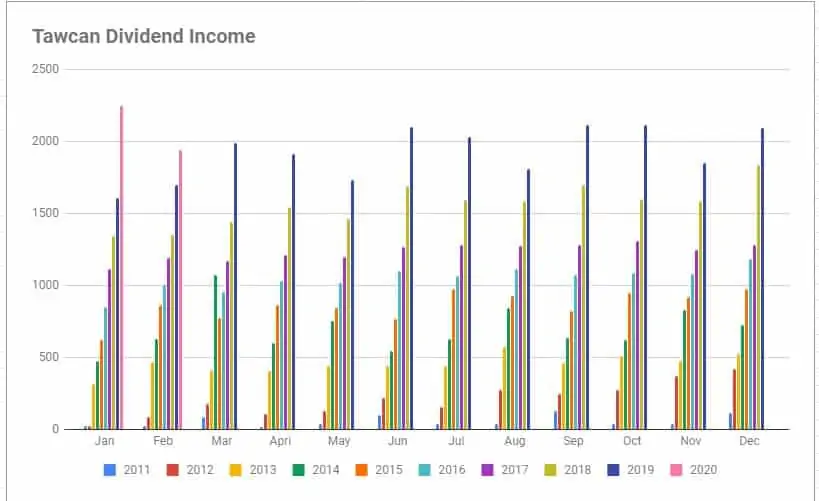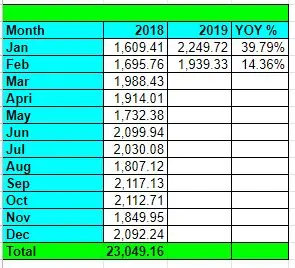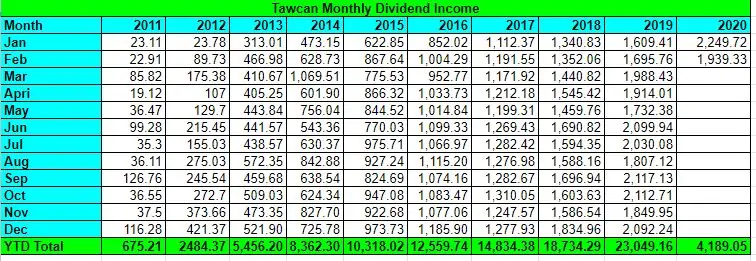February was a fun month for our family. We went snowboarding and skiing a couple of times at the local mountains. On the first outing, Baby T1.0 tried snowboarding (his 2nd time) and Baby T2.0 tried skiing (her first time). On the second outing, both kids tried skiing (Baby T1.0’s first time on skis) and Mrs. T and I were able to snowboard and ski as well. We took it really easy and stayed on the bunny hill both times (because it was free!). I was quite impressed with how well the kids did. Toward the middle of the second day, both kids were very comfortable on their skis. In fact, they were so comfortable they were going straight down the hill without doing any turns! We plan to go skiing/snowboarding a few more times before the season wraps up. We will have to teach them how to turn next time!
For those of new that are new to my monthly dividend income update, I am doing these updates to demonstrate it is possible to live off dividend income eventually. Another reason is to keep me accountable.
A quick reminder for those that aren’t familiar with our investment strategy:
- We are hybrid investors. Meaning we invest in both index ETFs and individual dividend-paying stocks. We utilize index ETFs to allow for geographical and asset diversification. We utilize individual dividend-paying stocks for the income predictability,
- Since we’re still in the accumulating phase, we are enrolled in dividend reinvestment plans (DRIP) whenever we are eligible. We also re-invest all of our dividends.
- We maximize our RRSP and TFSA contribution rooms every single. Once we finish that, we start contributing to our taxable accounts.
- We only invest US dividend-paying stocks in RRSP to avoid paying for the 15% withholding tax. We only invest REITs and income trusts in our TFSAs and RRSPs.
- We are 100% in equities.
A few readers reached out to me asking why we don’t invest in bonds. Aren’t we scared of a recession that could potentially wipe our portfolio value by 40% like what happened during the financial crisis?
Well, we do invest in bonds via my work’s RRSP where I could only invest in mutual funds. If we look at our overall investment portfolio, bonds made up a very small percentage. We also see our house as a method to hedge against a potential recession.
Since we are in our late 30’s, we feel that we can stomach a significant portfolio value drop. In fact, we welcome a significant drop in market valuation because that means we can purchase more stocks at a discount. When we are financially independent retired early (FIRE), we plan to live off our dividends rather than doing 4% withdrawals each year. Therefore, a drop in the portfolio value isn’t as a big concern to us, as long as the dividends are safe.
In late February we saw the quickest +15% drop in market value in history. While it’s disheartening to see our portfolio value drop quite a bit over the period of a week and a half, we reminded ourselves that this was just a little blip as the market simply dropped back to the October 2019 level. I have no doubt the market will recover and continue to go up once investors calm down about the coronavirus fear.
February Dividend Income
In February 2020, we received dividend payments from the following companies:
- Apple (APPL)
- AbbVie (ABBV)
- Bank of Montreal (BMO.TO)
- Costco (COST)
- Dream Office REIT (D.UN)
- Dream Industrial REIT (DIR.UN)
- Emera (EMA.TO)
- European Residential REIT (ERE.UN)
- H&R REIT (HR.UN)
- Inter Pipeline (IPL.TO)
- KEG Income Trust (KEG.UN)
- Laurentian Bank (LB.TO)
- National Bank (NA.TO)
- Omega Healthcare (OHI)
- Procter & Gamble (PG)
- Prairiesky Royalty (PSK.TO)
- RioCan REIT (REI.UN)
- Royal Bank (RY.TO)
- Starbucks (SBUX)
- SmartCentres REIT (SRU.UN)
- AT&T (T)
- Verizon (VZ)

After receiving 22 paycheques, it tallied up to $1,939.33. Unfortunately, February was a month that we didn’t break the $2,000 dividend income per month threshold. As mentioned before, February, May, August, and November have been the weakest months for us in terms of dividend income. Despite sub-$2,000 dividend income level, I am still pretty happy with the amount considering that only two years ago $1,939.33 would have been the highest monthly amount for that year.
Out of the $1,940.38 received, $407.45 was in USD and $1,531.88 was in CAD or about a 20-80 mix. Please note, we use a 1 to 1 currency rate approach. We do not convert dividends received in USD to CAD, because we want to keep the math simple. This is our way to avoid fluctuations in dividend income over time due to changes in the exchange rate.
The top five dividend payouts in January 2020 came from Bank of Montreal, Inter Pipeline, National Bank, Royal Bank, and Emera (not in order). These five companies’ dividend payouts accounted for $1,207.11 or 62.2% of our February dividend income.
Dividend Growth

Compared to February 2019, we saw a somewhat disappointing YoY growth of 14.36%. After an amazing 39.79% YoY growth in January, it was quite heartbreaking to see such a low matrix. I guess the impressive YoY growth is hard to maintain right?
Dividend Increases
February 2020 was a big month when it comes to dividend increases. The following stocks we own announced dividend increases:
- Intact Financial increased dividends by 9.21% to $0.83 per share.
- BPY increased dividends by 0.75% to $0.3325 per share.
- Suncor increased dividends by 11% to $0.465 per share.
- BCE increased dividends by 5% to $0.8325 per share.
- Manulife increased dividends by 12% to $0.28 per share.
- TC Energy increased dividends by 8% to $0.81 per share.
- PepsiCo increased dividends by 7.07% to $1.0225 per share.
- Walmart increased dividends by 1.9% to $0.54 per share.
- Royal Bank increased dividends by 2.9% to $1.08 per share.
- Magna International increased dividends by 10% to $0.40 per share.
- Coca-Cola increased dividends by 2.5% to $0.41 per share.
- Waste Management increased dividends by 6.3% to $0.544 per share.
- CIBC increased dividends by 1.4% to $1.46 per share.
- TD increased dividends by 7% to $0.79 per share.
All these raises increased our forward-looking dividend income by $388.65 Don’t think it’s significant? At a 4% dividend yield, this is equivalent to investing $9,716.25 in fresh capital. This is why organic dividend growth is so important!
Dividend Stock Transactions
Compared to January, February was a much quieter month when it came to dividend stock transactions. We only made a few transactions. We added:
- 20 shares of CIBC
- 36 shares of Telus
- 67 shares of Suncor
Unfortunately, we didn’t add these stocks during the week-long stock market meltdown at the end of the month. We have a little bit of cash on the side that we will deploy if the stock market continues to go down. At the same time, we are working hard to continue saving money each month, so we can increase our cash reserve.
These two purchases added $292.5 toward our forward-looking annual dividend.
Combined with the organic dividend increase, we managed to increase our forward-looking annual dividend by $681.15. That’s pretty awesome I have to say!
Summary

After two months in the books for 2020, we have received $4,189.05 in dividend income. If we calculate that on an hourly basis for all the days in the first two months of the year, that means our dividend portfolio is generating $2.91 per hour. If you didn’t catch the importance of that, it means every hour for every single day in January and February, we made $2.91 per hour without doing anything at all. Our money is working hard for us instead. The income is then re-invested to purchase more dividend-paying assets to increase our forward-looking dividend.
Pretty awesome I have to say.
Dear readers, how was your February dividend income?


Always looking forward to your monthly updates. Especially the summary of the growth over time is really inspiring and motivational. Thank you!
Great month! It will fun to see what reinvesting the dividends will do with the current market conditions. I’m excited about being able to put some cash to good use!
Scott
Thanks Scott. 🙂
Tawcan –
Good lord! So close to $2k in a quiet month for you. Congrats on the 15% growth. Your dividend increases really are propelling you in 2020, despite the volatility.
Impressive and motivating, as always.
-Lanny
Thank Lanny. Was hoping for more growth in Feb but I’ll take 15% than no growth. 🙂
Fantastic results Bob. Market value of my holdings are down about 25% now. As long as the dividends are paid life is good. Hold Fast everyone. Wish I had some more dry powder to distribute. You can get BNS today and get over 6% dividend. ENB over 7.5%. Crazy time.
“We also see our house as a method to hedge against a potential recession.” – care to elaborate?
It’s definitely crazy time. Some companies will probably forced to cut dividends but we will have to wait and see.
Re: House. Since we’re living in our house and have no plan to move anytime soon. The house acts as a bond to us since the value of the house won’t matter as long as we live in it and do not plan to sell.
Another solid month of results, Bob!
Starting to wonder now with companies talking about economic impact of the virus, will they start to preserve more cash and starting either cutting back on dividend growth or freeze them altogether. Time will tell…my focus is to maintain my asset allocation through the swings.
Thanks man. Hopefully companies will continue to pay dividends. I guess time will tell.
Great job Bob! It’s so inspiring to see that you are growing your dividend yoy. My wife, daughter and I are following your blog and have started our journey in achieving one day FIRE. In the meantime, we’re invested in dividend paying stocks and low cost indeX ETFs. Out of curiosity, do you and Mrs. T invest Baby 1 and 2’s RESPs in equities? We have started to do it for our daughter (who is now 5 month’s old). We see that she’ll have at least a 17-18 yr horizon before she uses those funds for university/college/trade school so it seems like investing in equities is a good way to maximize ROI. Let me know what you think. Cheers!
Hi Lawrence,
Thank you for following along, appreciate it. We down hold both kids’ RESP in equities – low cost index ETFs. Right now using multi-ETFs but have been seriously considering switching to the one fund ETF.
nicely done!
minor quibble “In late February we saw the quickest +15% drop in market value in history.”
– well not quite – the Dow dropped 22.6% on October,19 1987 (in one day!) – I lived through that one too 🙂 – biggest point drop happened in 2020, yes, but not on a percentage basis.
Ah from what I read people were saying this was the quickest drop in history. Good to know, thanks.
see https://www.wikiwand.com/en/Black_Monday_(1987)
also see
https://www.snopes.com/fact-check/largest-stock-drops-trump/
– and no I am NOT supporting Trump – a very unfortunate and dangerous abreration in history
These posts are great education tools, thank you so much for taking the time to share. Can you point me to how I setup a forward-looking annual dividend spreadsheet? I have a monthly dividend goal in mind but that is in today’s dollars. I can’t figure out what this months dividend means 10 years down the road. I assume that’s what forward-looking annual dividend means. Thank you.
Thank you. You can take a look here:
https://www.tawcan.com/step-step-guide-make-google-spreadsheet-dividend-portfolio-template/
Forward-looking annual dividend simply means the dividend amount you’ll receive in a year looking forward. So if today is January 1st, what your annual dividend would be.
wow very nice Bob. Still a great growth rate yr over yr.
Lots of raises and the added forward income from raises drips and new capital last month is huge.
keep doing what your doing.
cheerz man
Thanks man, it was definitely a great month for dividend raises. 🙂